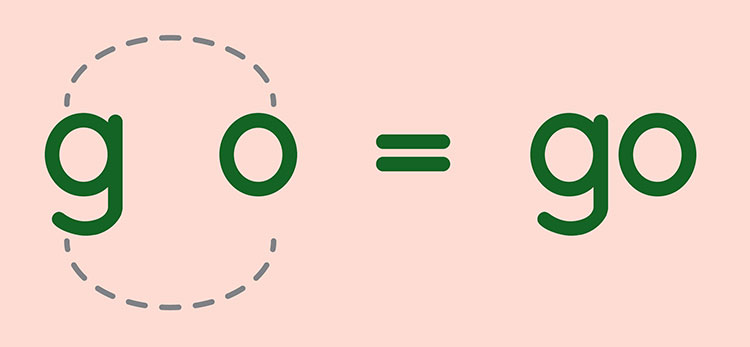J2: Connect the Sounds
1. Overview
Blend two sounds together, in order, to make a word. NOTE: This activity is about counting and ordering the sounds in words. It is not about spelling!
J2: Connect the Sounds
2. Materials
Print the word list, but do not show it to the child. This is for the adult’s reference only. ↑ Top3. Activity
Video: How to play Connect the Sounds
Explain to the child that you are going to play a new game. You will say a letter sound (a consonant or digraph) and a letter name (a long vowel sound), and she has to figure out what word they make when you put them together.
Face the child, and hold up your right hand next to your face, with the palm facing you. When you say the first sound, stick up your index finger to signal that this is the first sound. When you say the second sound, hold up a second (middle) finger as well, to signal that this is the second sound.
Demonstrate the game for the child, like this:
Adult: I’m going to say a letter sound and a letter name. Let’s see if you can put them together to say a word. Listen carefully: /nnn/ [raising 1 finger] /O/ [raising 2 fingers] Again. Listen: /nnn/ • • • /O/ [raising 1 and then 2 fingers] Now I’ll say it fast: no!Now involve the child in the game:
Adult: Now you try to figure out this word. Listen carefully: /A/ • • • /t/ [raising 1 and then 2 fingers] Again. Listen: /A/ • • • /t/ [raising 1 and then 2 fingers] Now you say those sounds while I raise my fingers. [raise 1 finger] Child: /A/ Adult: [raise 2 fingers] Child: /t/ Adult: Yes, /A/ • • • /t/. Say those sounds fast. Child: Um…ate! Adult: Yes, ate. “I ate my dinner.”Start out with a series of words made up of a continuant consonant sound and a long vowel sound. These sounds are easier for children to blend. Then move on to words with a stop-sound consonant and a long vowel sound. Finally, give the child a random mix of these two types of words. ↑ Top
4. Confidence Builder
If the child struggles, let her touch your raised fingers and say the sounds in unison with you. If she struggles to blend the two sounds into a word, shorten the pause (from 1.5 seconds to 1 second or even 1/2 second) between the two sounds. ↑ Top5. Extension
Do the activity as written above, but do not hold up your fingers as you say each sound. ↑ Top6. Variation
Have the child close her eyes and listen to the two sounds without any visual clue. Then she should say the whole word when you ask, “What word?” ↑ Top7. Small Groups (2-5 children)
Lesson Objective: Children will blend two spoken phonemes together to produce a two-phoneme spoken word. (NOTE: The objective of this lesson is to order and blend sounds into words; it has nothing to do with spelling!) GELDS (Georgia Early Learning & Development Standards): CLL7.4a Georgia Standards of Excellence: ELAGSEKRF3.b Common Core State Standards: CCSS.ELA-LITERACY.RF.K.3.B Adaptation: Read the main activity, watch the video, and follow the instructions above, with the following changes: This activity may take several sessions. Select words from the word list, beginning with words that have a continuant consonant sound and a long vowel sound. Practice the activity as a group, letting all the children respond. Give the same consonant sound and vowel name to each child. Have them put the sounds together to make the word. Then give each child a different letter sound and letter name to put together. It can be helpful and engaging for the children to fist their left hand when they repeat the first phoneme, fist their right hand when they repeat the last phoneme, and then touch their fists together, side-by-side, when they blend the two phonemes into a spoken word. (See the small group adaptation for Activity D1.) In later sessions move on to words with a stop-sound consonant. Once children understand the concept of making words with the more difficult stop-sound consonants, give a random mix of the two types of words (with stop-sound and continuant consonants). Provide many opportunities for practice. Reinforcement: Play the game again, asking the children to make a sentence with the new word they just made. Use this Reinforcement at Home form to tell parents and guardians how they can reinforce lessons outside the classroom. ↑ TopLeave a Reply

2 Responses to “J2: Connect the Sounds”
Thu Nguyen
I wonder why the sound /aaa/ + / ttt/ is ATE but AT in the video? Thanks for giving your time to answer my question. Loves.
ADMIN – Hi Thu,
Thank you for contacting us. All the words in this activity involve connecting a consonant sound to a long vowel sound to form a word. The last AT in the video is simply to reinforce the formed word when connecting A+t. I understand why that could be confusing. What we didn’t want to do was to correctly spell ate since the e is silent. The whole point of the exercise is to count and connect the number of spoken sounds that form a given word. In future edits, we will eliminate that visual representation of the blended sounds used to create the word, ate.
Ayesha Siddiqa
Actually, this website helps a lot in teaching students blending.